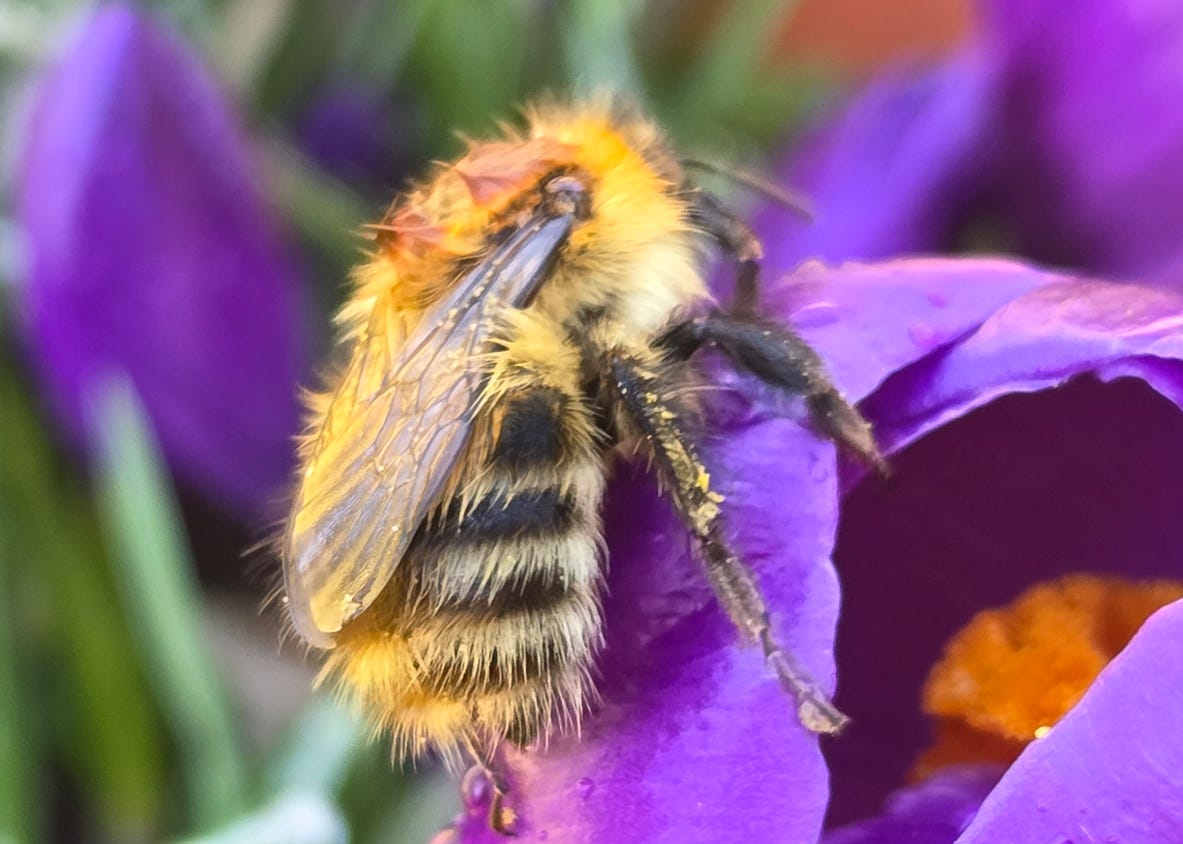Bumblebees, who in my view are essentially tiny, adorable little teddy bears with wings and a fondness for marmalade sandwiches nectar, are also great acrobats. We’re still only in April, and already I’ve lost count of how many photos I’ve taken this year of bumbles clinging onto flowers upside down as they drink nectar.
Here’s a lovely little common carder, for example, feeding on a comfrey flower on 15 April. (She’s so fabulously orange! Squeeeee!)
And an equally adorable early bumblebee on the same day, also feeding on comfrey.
Another shot of the same early bumble:
Have a closer look at the bumbles’ feet in those three pics, and you’ll see that each foot has two tiny claws, called tarsal claws, which the bees are using to grip onto the outside of the flowers. The claws look like grappling hooks, or I suppose really it would be more accurate to say that grappling hooks look like bees’ feet, as bees have been on this earth for many tens of millions of years, and grappling hooks rather less than that.
Below, here’s a garden bumblebee feeding on the comfrey (of which I have a large patch) on 17 April. On the far right of the pic are her two antennae close together, and on the left of them, you can see her tongue going into the flower to drink the nectar. She’s clinging onto the flower with her clawed feet.
Below, another garden bumblebee landing on a comfrey flower on 11 April.
Below, this is a rubbish blurry photo* of a common carder on 15 April, but I’ve added it here as the part of the pic where you can see her claws clinging onto the flower is clear.
* Totally her fault for moving at the wrong moment, nothing whatsoever to do with my photography skills or lack thereof. :-D :-D
Below is the same gorgeously orange common carder from the first pic; her back legs are quite wide apart in this one as she clings on in the position that best enables her to drink the nectar in that particular comfrey flower.
And here’s another carder feeding on the comfrey on 22 April:
As well as having those claws that enable them to cling to surfaces upside down, I’ve read that bumblebees and honeybees have pads on their feet that are adhesive and enable them to ‘stick’ to smooth surfaces. I don’t have any photos or any experience of this myself, so am quoting from this site: “Between the claws is an adhesive pad. This secretes a liquid so that the foot can stick to a smooth surface by surface tension…To walk on a smooth surface, the bee unfolds its feet and uses the sticky pads, placing each pad down and then peeling it off in exactly the right way to detatch it.” Amazing! Apparently, honeybee pads are much bigger than those found on bumblebee feet, so that honeybees have more dexterity when walking on smooth surfaces than bumbles do.
In early March, I did see a couple of bumblebee queens falling off flowers. I posted a vid of a buff-tail bumble falling off a crocus and hitting her bottom on another crocus. Here she is, poor little thing. (She was completely fine!)
Shortly before the above post, I posted about a little carder queen I helped into a crocus (see here and here). The next day, when it was warm and sunny, she came out of the crocus with the fuzz on the back of her head wet from the rain we’d had the day before. I took a photo of her just before she fell off the crocus. Oops.
Below, this is what a common carder bumblebee queen looks like with wet fuzz. Awwww.
Below: moments after I took the pic above, she fell off the flower into the soil. I managed to get another pic of her crawling back up the crocus stalk.
When I went back about an hour and a half later, she’d dried off nicely in the sun, and was getting herself all covered in pollen inside a crocus. And not too long after this, she flew off to begin the search for a nesting site. Yay!
To be fair, both the carder and the buff-tail hadn’t long emerged from a very long hibernation, and were still finding their feet, as it were, and not quite as agile as they were surely to become. I mean, I’m not exactly graceful in the early morning after being in bed for eight hours, never mind eight months. And, going back to bees’ feet, I’m as amazed, stunned and humbled as always by the wondrousness of nature.
















Love the shots you manage to get of these bees! When the bee fell from the birdbath last year -(the episode that brought me to write a poem about it all), I watched her use those 'feet' or 'claws' to wipe the water off of her face. I didn't take a shot of that though, I was too much in awe just watching her!
Beautiful, Kate!
I know you're rewilding a multi-acre site. Would be curious to see you pull back your camera and give us an overview of what you're doing with that whole space. Only if you want to do that, of course!